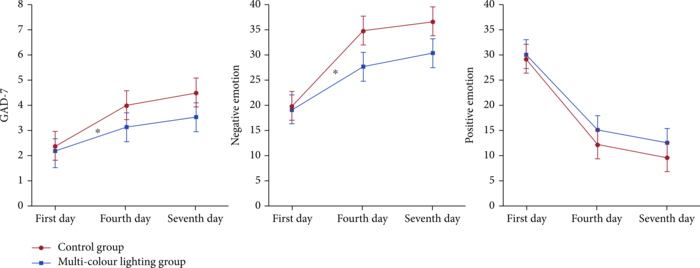How to alleviate the increase in anxiety and negative emotions caused by confined and isolated conditions

Emotion and anxiety levels of the multicolour lighting group and the control group on the first, fourth, and seventh days
As missions for deep space exploration and space habitats are put on the agenda, astronauts need to withstand being tested by multiple stressors in confined and isolated conditions during such long flights, especially because in deep space exploration, problems such as signal delays make astronauts feel the anxiety of being far away from Earth and the psychological fear of deep space. According to a series of experiments conducted recently on Earth and during current space missions aboard the International Space Station (ISS), NASA believes that monotony of vision, in particular, aggravates the crew's anxiety, irritability, depression. Moreover, a large number of studies have also found that crew members on long-term missions on the Antarctic Space Simulation Station are extremely susceptible to psychological problems caused by visual monotony and monochromatic colors. In a research paper recently published in Space: Science & Technology, Ao Jiang from European Space Agency conducted a study to test whether multicolor lighting can improve people’s psychological state in an isolated and confined environment over a period of seven days.
The author first prepared the necessary materials and methods. Twenty healthy participants (10 males and 10 females, all of Chinese nationality and mostly 21 to 27 years old) from Xiangtan University were selected. Twenty isolation wards of the Xiangtan Central Hospital were used, which were all 3.5 meters long, 3 meters wide, and 2.2 meters high. Each room was furnished with a chair and a table, a bed, and a bedside table. The walls and the ceiling were painted white and the floor dark grey These were the two main colors, apart from the door, chair, table, and dresser, which were a light wood color. Neutral colors were used to reduce any effects of the room on the colors to be used in the experiment. Moreover, Philips Hue Bluetooth wireless 16 million color dynamic light bulbs were chosen to project the colored light in the multicolor lighting rooms. The multicolor lamp was placed in the middle area between the desk and the bed in the isolated room to ensure that the participants were affected by the multicolor lighting in most daily activities. Besides, the PANAS questionnaire, a self-report measure, were used to assess the specific states that emerge from general dimensions of positive and negative emotional experiences, and the GAD-7 questionnaire, a one-dimensional scale, were designed to assess the presence of the symptoms of generalized anxiety disorder (GAD). As for statistical analysis, a chi-square general linear model repeated measures (GLM-RM) was used to measure the effect of isolation on emotion, anxiety, and self-rated health scores.
Afterwards, the experiment got started. Twenty participants were randomly divided into two groups: one group that was exposed to multicolor lighting and a control group, which was exposed to a static, monotonous white interior. In the multicolor lighting group, from 8 a.m. to 10 p.m. every day, the color of the multicolor light was randomly changed every three hours. Each participant entered a separate isolation room. During the isolation, the participants were not allowed to use any carriers such as mobile phones, computers, TVs, or iPads. But they could read paper books and do yoga and other activities. The participants’ psychological state was recorded on the first day, the fourth day, and the seventh day. At 4:00-5:00 p.m. on the test day, the experimenters asked the participants to start filling out the paper questionnaire. After the questionnaires were completed, semi-structured interviews were conducted to record the participants' self-evaluation and subjective feelings. Each interview lasted about 5-10 minutes and was recorded for subsequent transcription and qualitative analysis.
The results of the control group showed that the participants' negative emotions and anxiety continued to increase over time, whereas the group randomly exposed to multicolor lighting that changed every three hours did not show any significant increase in negative emotions and anxiety. The most significant effect was observed on the fourth day, GLM-RM analysis indicated that the anxiety level on the fourth day was significantly higher than that on the first day in both groups. On the seventh day of the experiment, the anxiety level was also significantly higher than that on the first day, but there was no significant difference between the level of anxiety on the fourth day and on the seventh day. In conclusion, multicolor lighting was found to alleviate the increase in anxiety and negative emotions caused by isolation and confinement. Moreover, the random change of light color in the isolated environment appeared to help the participants get an increased sense of surprise to counteract the monotony of the isolation, with an effect similar to that of circadian lights. In future space exploration, colored lighting or other sensory adjustment interventions could be used in addition to teamwork and collective life to reduce negative emotions and anxiety feelings.
Reference
Author: Ao Jiang, Irene Lia Schlacht, Xiang Yao, Bernard Foing, Zhixiong Fang, Stephen Westland, Caroline Hemingray, and Wenhao Yao
Title of original paper: Space Habitat Astronautics: Multicolour Lighting Psychology in a 7-Day Simulated Habitat
Article link: https://doi.org/10.34133/2022/9782706
Journal Title: Space: Science & Technology
DOI: 10.34133/2022/9796015
Affiliations:
College of Electrical and Information Engineering, Hunan University, Changsha, China
Institute of Manned Spacecraft System Engineering, China Academy of Space Technology (CAST), Beijing, China
Institute of Artificial Intelligence and Robotics, Xi'an Jiaotong University, Xi'an, China
School of Mechatronical Engineering, Beijing Institute of Technology, Beijing, China












